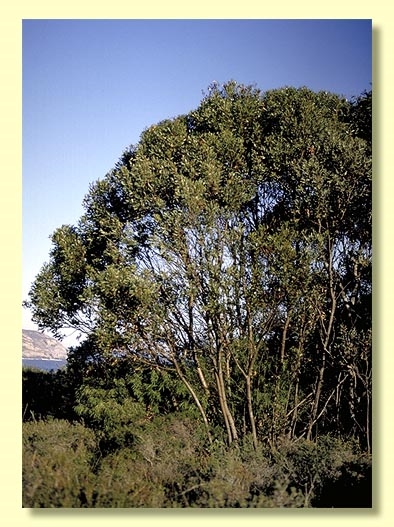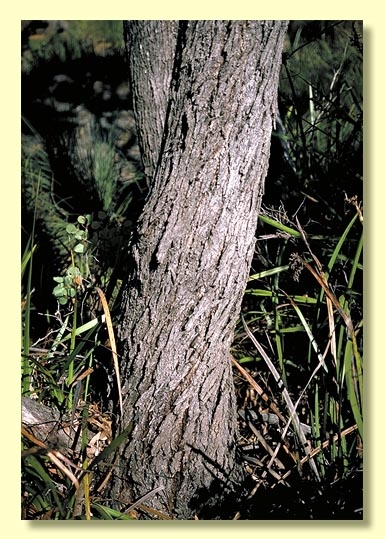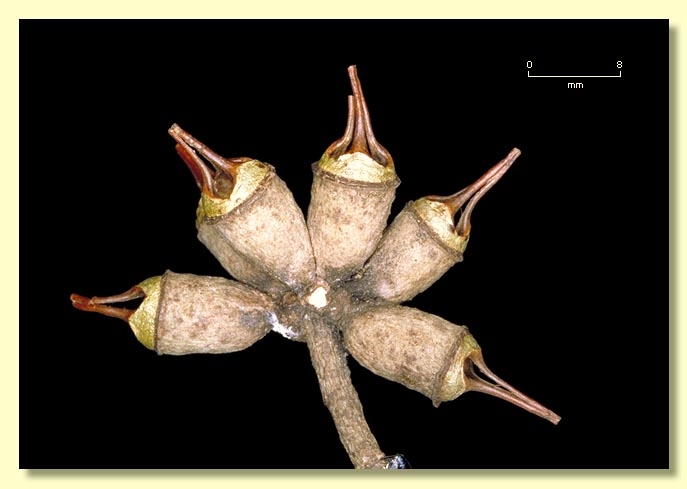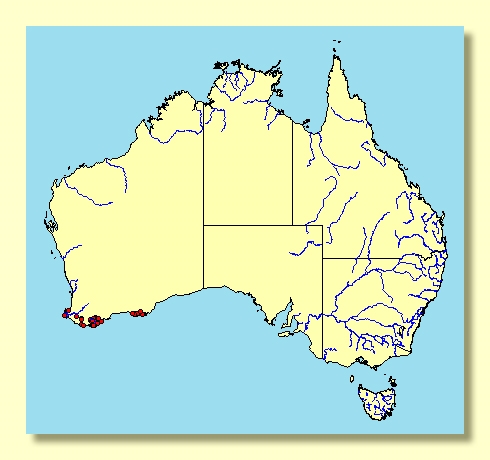Euclid - Online edition
Eucalyptus cornuta
Eucalyptus | Symphyomyrtus | Bisectae | Hadrotes | Cornutae
T: Observatory Is., [W.A.], 13 Dec. 1792, J. de Labillardière s.n.; holo: FI; iso: BM, G, K, LE, LINN, MEL.
E. macrocera Turcz., Bull. Soc. Imp. Naturalistes Moscou 22(2): 20 (1849). T: W.A., J.Drummond 4: 67; holo: L; iso: BM, CGE, K.
Bark rough over part or all of trunk, rarely to branches ca 8 cm diameter, more or less hard, thick and fissured to thin and fibrous, brown to grey or almost black, smooth above pale grey and grey-brown.
Branchlets with or without oil glands in the pith.
Juvenile growth (coppice or field seedlings to 50 cm): stems rounded in cross-section, smooth; juvenile leaves always petiolate, alternate, ovate to orbicular, 4–7 cm long, 2–7 cm wide, margin sometimes irregular and undulate, apex rounded to pointed, green, discolorous.
Adult leaves alternate, petioles 0.5–2 cm long; blade commonly lanceolate, rarely oblong-elliptical, (5)6–13.5(15.2) cm long, 1–3.3 cm wide, base tapering to petiole, margin entire, apex usually pointed, rarely blunt, concolorous, usually glossy, green, side-veins at an acute or wider angle, reticulation dense, intramarginal vein remote from margin, oil glands island and intersectional.
Inflorescence axillary unbranched, peduncles rounded to flattened, 1.2–3.2 cm long, buds ?11 to 21 or more per umbel, sessile or rarely pedicellate (pedicels 0–0.3 cm long). Mature buds very elongated, 2.3–4.2 cm long, 0.5–0.8 cm wide, scar present (outer operculum lost early) but may be obscure by bud maturity, operculum horn-shaped curved or straight, 4–7 times the length of the hypanthium, blunt or pointed, stamens erect, anthers narrowly oblong, versatile, dorsifixed, dehiscing by longitudinal slits, style long and straight, stigma tapering, locules 3 or 4, the placentae each with 4 (rarely 6) vertical rows of ovules. Flowers yellowish.
Fruit usually sessile, rarely pedicels to 0.3 cm long, cylindrical to cup-shaped, 0.5–1.2 cm long, 0.6–1.3 cm wide, dehiscing by elliptical holes formed when the 3 or 4 valves split along the sutures but remain fused at the fragile tips, disc covering the valves.
Seeds black, 1.5–3 mm long, ovoid to angularly ovoid, dorsal surface very shallowly reticulate, margin in some seed partially flanged, hilum ventral/terminal.
Cultivated seedlings (measured at node 10): cotyledons Y-shaped to bilobed (the arms short and broad); stems rounded in cross-section, smooth; leaves always petiolate, opposite for 3 to 5 nodes then alternate, orbicular to broadly and bluntly ovate or deltoid, 2.5–6.5 cm long, 2–5.5 cm wide, margin slightly undulate, apex rounded to emarginate, discolorous, green, not scabrid.
Flowering time unknown.
A small to tall tree or rarely a mallee, endemic to Western Australia, of coastal and subcoastal distribution from the western seaboard near Margaret River east as far as Gairdner River estuary in Fitzgerald River National Park. There is a disjunct occurrence further east from Esperance to Orleans Bay and the islands of the Recherche Archipelago. The bark is rough on the lower half of the trunk and the adult leaves glossy, green to olive-green. Buds are elongated and the fruit has prominent fragile valves that remain united apically after shedding seed.
Eucalyptus cornuta belongs in Eucalyptus subgenus Symphyomyrtus section Bisectae subsection Hadrotes because the cotyledons are coarsely bisected to bilobed, buds have an operculum scar, a long inner operculum and erect stamens, fruit are large, thick-rimmed and held rigidly. There are 10 species in subsection Hadrotes; however, only two of these, E. cornuta and E. macrandra, have oil glands in the pith of the branchlets and non-scabrid seedlings. Together they form series Cornutae.
E. cornuta is distinguished from E. macrandra by having the valve-tips remaining fused after seed-shed of the fruit, like species of the more distantly related E. lehmannii group. E. macrandra however has flat-topped fruit with free (not united) valve tips. E. cornuta has buds in cluster of up to 21, whereas E. macrandra can have up to ca 50 buds. The operculum of E. macrandra is longer and more slender than in E. cornuta.
A specimen of E. cornuta from North Twin Peak Island differs from more typical plants in having six ovule rows and elliptical to oblong leaves and may be worth further study.
E. cornuta has been widely cultivated in southern Australia as an ornamental or windbreak tree. It produces one of the hardest and strongest timbers in the world. Most of the trees of commercial value have been logged years ago.













